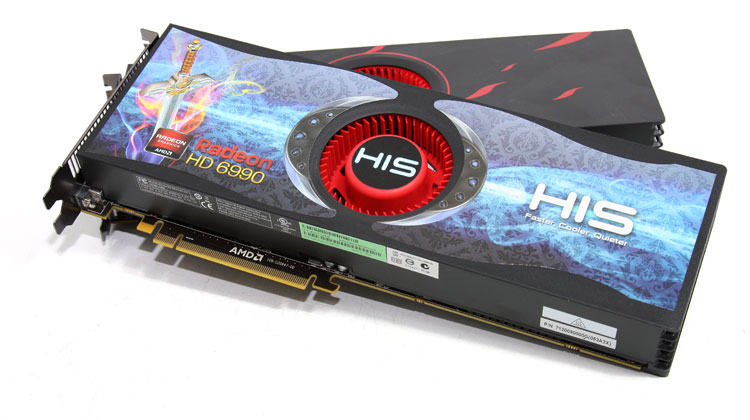An Islands Euphemism & Family Tree & Architecture
An Islands Euphemism & Family Tree
AMD/ATIs naming scheme has not been rather clear lately. Next to a recent change in the Radeon HD 6000 numbering scheme, you'll have heard codenames flying around as well. Next to that AMD silently eliminated the ATI branding, which in fact has now become AMD.
Let's first dig our teeth in that and explain what is going on.
A bit of confusion out there on the street, is that people call the one released today "Antilles" -- which in fact are two "Cayman" graphics processors slapped onto one graphics card. As you might remember in the past ATI (now AMD) assigned code numbers to the GPU used on these graphics cards AKA RV770 or something. Though we are quite confident that the design team still uses that numbering scheme, AMD marketing however wanted to give it a little more TLC and as such each GPU family has a codename, and each GPU deriving from that family has a codename as well.
The previous generation GPUs were named after Evergreen trees which was the family codename; products deriving from that range known as Cypress, Juniper, Redwood and Cedar.
For the Radeon HD 6000 series generation the products are codenamed after islands in the Caribbean, in this case Northern Islands depending on how you look at geographical location, of course.
When we subdivide the Northern Islands groups we get small segments of islands, each GPU range is named after an island for all new Radeon HD 6000 series products, ready? Here they are... Barts, Cayman, Blackcomb, Antilles and Whistler.
When the Radeon 6850/6870 was released in October 2010, the GPUs empowering them carried codename Barts. Bart is named after Saint Barthélemy island and will be the performance/upper-mid segment GPU series. But that still leaves Cayman, Blackcomb, Antilles and Whistler.
Today's high-end products are based on a GPU called "Cayman" (after the Cayman Islands) which is the high-end product in the AMD Radeon HD 6900 series, and that's a change as well, as previously the 5800 series, was the most high-end.
And while we're still on the island rollercoaster , today we test "Antilles", named after the Antilles Islands of course. Antilles is a group of islands, get it... group? As in multiple. As such Antilles is a dual-GPU graphics card that makes use of two Cayman GPUs, positioned in the Radeon HD 6900 series of product, carrying the consumer name Radeon HD 6990.
So in a nutshell, Antilles is based on two Cayman GPUs = Radeon HD 6990. Let's move onwards to the actual product. First a word or two on the Cayman GPU.
An Architecture Change
Last year's released cards in the 6800 "Barts" series were the 6850 and 6870. These cards merely received a small architectural optimization/tweak over the last generation architecture, Cypress. With the Antilles/Cayman products, things have changed a little bit as the fundamental section of the GPU, the Shader processor setup underwent a significant change, and we are still debating whether or not it was a good one.
AMD moved from a VLIW5 (also knows as VEC5) towards a VLIW4 SIMD shader processors setup. We are not going to discuss the VLIW4 thread processor setup in much detail but basically what this means is that AMD went from a VLIW5 configuration, that used four simple SIMD units and one complex t-unit (transcendental unit) in order to build a stream processing unit, to a VLIW4 configuration that uses four stream units which feature equal capabilities, two of them being assigned with special functions.
AMD however claims this change will bring them 10% more performance over the previous thread processor setup, better scheduling and register management. We think it was merely a design change to save on the number of transistors which you can re-use to add more shader processors on the processor die.
Next to this rather significant change, there are more changes to be found on the graphics card. It has upgraded render back ends (ROPS) with a redesigned Z-Stencil and ROP unit architecture consisting of 128 Z/Stencil ROPs, and 32 color ROPs, up to 2 times faster in 16-bit integer operations and two to four times faster in 32-bit floating point operations which will have you in AA performance, much faster GDDR5 memory, and we also spot a series of improved compute features that will help out in performance in that segment.
One other detail that you might find interesting is that when you look at the block diagram, you'll notice that the GPU pretty much looks like a dual-core processor. AMD calls this dual graphics engines. Anyway, have a peek at the block diagrams if at all interested.
Alright, some more generic information to grasp. Each Cayman GPU itself is based on a 40nm fabrication process and harbors a blistering 2.64 Billion transistors. The graphics engine can have up-to 24 shader clusters, with each engine holding 64 shader processors. Do the reverse math and you'll quickly learn that the most high-end GPU will count 1536 shader processors. A bit of an unusual number and we just wonder if there isn't more to be found of them inside that die really.
The Cayman chip has up-to 96 Texture Units and can produce 2.7 TFLOPs of single precision performance.
Memory wise AMD of course stuck to it's fine working GDDR5 setup, and yes it is still based on a 256-bit memory bus.
So what about the HIS Radeon HD R6990 ?
So with this knowledge in mind, we can now look into the specifications or the R6990 a little more in-depth, next page please.




